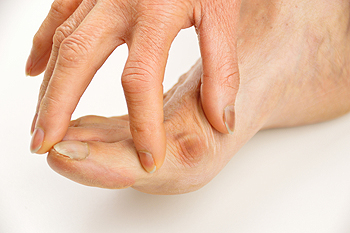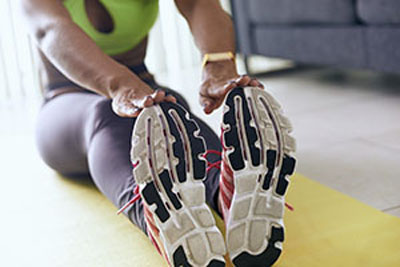Houston
Pearland
 A bunion is defined as a bone that grows on the side of the big toe. It is often a nuisance, and wearing shoes may become difficult. Symptoms can include redness, swelling, and corns that may form on top of the bunion as a result of excess friction. The common reason patients may develop bunions is wearing shoes that do not have adequate room for the toes to move freely in, or bunions may form due to genetics. Some patients find mild relief when a protective pad is worn over the bunion, and when supportive shoes are worn. Additionally, wearing custom made orthotics may bring the relief that is needed. In severe cases, surgery may be an option to consider for permanent removal. If you have bunions, it is suggested that you visit a podiatrist.
A bunion is defined as a bone that grows on the side of the big toe. It is often a nuisance, and wearing shoes may become difficult. Symptoms can include redness, swelling, and corns that may form on top of the bunion as a result of excess friction. The common reason patients may develop bunions is wearing shoes that do not have adequate room for the toes to move freely in, or bunions may form due to genetics. Some patients find mild relief when a protective pad is worn over the bunion, and when supportive shoes are worn. Additionally, wearing custom made orthotics may bring the relief that is needed. In severe cases, surgery may be an option to consider for permanent removal. If you have bunions, it is suggested that you visit a podiatrist.
If you are suffering from bunion pain, contact Dr. Linda D. Nachmani of Central Foot & Ankle Associates. Our doctor can provide the care you need to keep you pain-free and on your feet.
What Is a Bunion?
Bunions are painful bony bumps that usually develop on the inside of the foot at the joint of the big toe. As the deformity increases over time, it may become painful to walk and wear shoes. Women are more likely to exacerbate existing bunions since they often wear tight, narrow shoes that shift their toes together. Bunion pain can be relieved by wearing wider shoes with enough room for the toes.
Causes
Symptoms
In order to diagnose your bunion, your podiatrist may ask about your medical history, symptoms, and general health. Your doctor might also order an x-ray to take a closer look at your feet. Nonsurgical treatment options include orthotics, padding, icing, changes in footwear, and medication. If nonsurgical treatments don’t alleviate your bunion pain, surgery may be necessary.
If you have any questions, please feel free to contact one of our offices located in Houston, and Pearland, TX. We offer the newest diagnostic and treatment technologies for all your foot care needs.
Read more about Bunions Deep cracks in the skin on the heel are known as fissures. They can be caused by standing on hard surfaces for long periods of time during the day, or from wearing shoes that have an open back. The skin can become dry, and the consistent pressure the heels endure for most of the day may cause this ailment to occur. Additionally, specific medical conditions including eczema and psoriasis may play a significant role in developing cracked heels. The severity of this condition may be prevented by frequently drinking plenty of fresh water, wearing shoes that have cushioned heel areas, and eliminating existing vitamin deficiencies. Relief may be found when a good moisturizer is applied to the affected area daily. If you have cracked heels, it is suggested that you speak with a podiatrist who can effectively treat this condition.
Deep cracks in the skin on the heel are known as fissures. They can be caused by standing on hard surfaces for long periods of time during the day, or from wearing shoes that have an open back. The skin can become dry, and the consistent pressure the heels endure for most of the day may cause this ailment to occur. Additionally, specific medical conditions including eczema and psoriasis may play a significant role in developing cracked heels. The severity of this condition may be prevented by frequently drinking plenty of fresh water, wearing shoes that have cushioned heel areas, and eliminating existing vitamin deficiencies. Relief may be found when a good moisturizer is applied to the affected area daily. If you have cracked heels, it is suggested that you speak with a podiatrist who can effectively treat this condition.
If the skin on your feet starts to crack, you may want to see a podiatrist to find treatment. If you have any concerns, contact Dr. Linda D. Nachmani from Central Foot & Ankle Associates. Our doctor can provide the care you need to keep you pain-free and on your feet.
Cracked Heels
It is important to moisturize your cracked heels in order to prevent pain, bleeding, and infection. The reason cracked heels form is because the skin on the foot is too dry to support the immense pressure placed on them. When the foot expands, the dry skin on the foot begins to split.
Ways to Help Heal Them
Ways to Prevent Cracked Heels
If you are unsure how to proceed in treating cracked heels, seek guidance from a podiatrist. Your doctor will help you with any questions or information you may need.
If you have any questions, please feel free to contact one of our offices located in Houston, and Pearland, TX. We offer the newest diagnostic and treatment technologies for all your foot care needs.
Read more about Solutions for Cracked Heels Children who are learning to walk may start out with their toes going inward or outward. These types of gaits typically do not cause pain and may improve as the child gets older. If the gait does not get better, it may be the result of bones that are growing incorrectly. This can be an ailment that slowly develops, and it may be beneficial to record a video of your child walking every year to see if there is a decline or improvement. It is suggested that you seek the counsel of a podiatrist if any foot condition does not get better by approximately three years of age.
Children who are learning to walk may start out with their toes going inward or outward. These types of gaits typically do not cause pain and may improve as the child gets older. If the gait does not get better, it may be the result of bones that are growing incorrectly. This can be an ailment that slowly develops, and it may be beneficial to record a video of your child walking every year to see if there is a decline or improvement. It is suggested that you seek the counsel of a podiatrist if any foot condition does not get better by approximately three years of age.
The health of a child’s feet is vital to their overall well-being. If you have any questions regarding foot health, contact Dr. Linda D. Nachmani of Central Foot & Ankle Associates. Our doctor can provide the care you need to keep you pain-free and on your feet.
Tips for Keeping Children's Feet Healthy
If you have any questions, please feel free to contact one of our offices located in Houston, and Pearland, TX. We offer the newest diagnostic and treatment technologies for all your foot care needs.
Read more about How to Care for Your Child's Feet Dry, cracked skin between your toes can be caused by athlete’s foot, a fungal infection of the skin, also known as tinea pedis. Athlete’s foot is an extremely common condition, affecting millions of people each year. When you have athlete’s foot, the skin between your toes may become itchy, flaky, thickened, white, or swollen. This condition can also cause skin redness and pain in your feet. The most common treatment for athlete’s foot is a topical antifungal medication that kills or prevents the growth of the fungus. If you suspect that you have athlete’s foot, it is recommended that you see a podiatrist for a diagnosis and treatment.
Dry, cracked skin between your toes can be caused by athlete’s foot, a fungal infection of the skin, also known as tinea pedis. Athlete’s foot is an extremely common condition, affecting millions of people each year. When you have athlete’s foot, the skin between your toes may become itchy, flaky, thickened, white, or swollen. This condition can also cause skin redness and pain in your feet. The most common treatment for athlete’s foot is a topical antifungal medication that kills or prevents the growth of the fungus. If you suspect that you have athlete’s foot, it is recommended that you see a podiatrist for a diagnosis and treatment.
Athlete’s foot is an inconvenient condition that can be easily reduced with the proper treatment. If you have any concerns about your feet and ankles, contact Dr. Linda D. Nachmani from Central Foot & Ankle Associates. Our doctor will treat your foot and ankle needs.
Athlete’s Foot: The Sole Story
Athlete's foot, also known as tinea pedis, can be an extremely contagious foot infection. It is commonly contracted in public changing areas and bathrooms, dormitory style living quarters, around locker rooms and public swimming pools, or anywhere your feet often come into contact with other people.
Solutions to Combat Athlete’s Foot
Athlete’s foot can cause many irritating symptoms such as dry and flaking skin, itching, and redness. Some more severe symptoms can include bleeding and cracked skin, intense itching and burning, and even pain when walking. In the worst cases, Athlete’s foot can cause blistering as well. Speak to your podiatrist for a better understanding of the different causes of Athlete’s foot, as well as help in determining which treatment options are best for you.
If you have any questions please feel free to contact one of our offices located in Houston, and Pearland, TX. We offer the newest diagnostic and treatment technologies for all your foot and ankle needs.
Read more about Athlete’s Foot